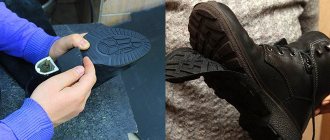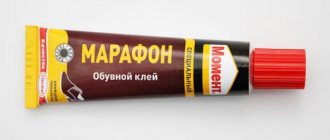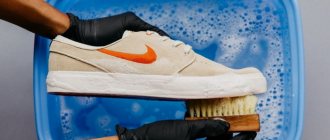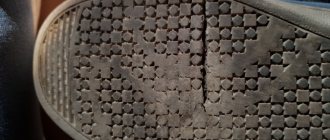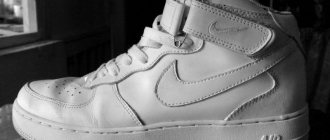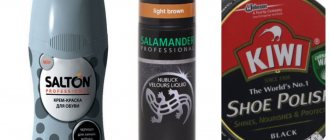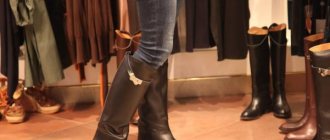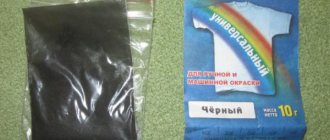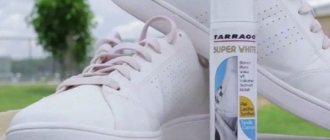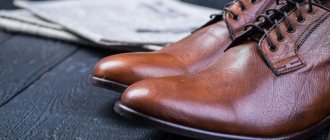Cleaning the sole before painting
To ensure that the paint lays evenly and is absorbed evenly, the surface should be thoroughly cleaned. You need to wash off the dirt from your shoes, immediately wipe with a dry cloth, then dry well away from sources of heat and sunlight.
A clean, dry surface is degreased with diluted alcohol, vodka or soap solution with the addition of ammonia. To prepare such a solution, you need to grate laundry soap and dissolve it in warm water. Stores sell special degreasing products.
Using the eraser
Black stripes often appear on the soles of sneakers or rubber boots. They are easily erased with a soft paper eraser.
Toothpaste
Stubborn stains on the soles of sports shoes can be removed with toothpaste. Apply it to a soft brush (a toothbrush will do) and rub in in a circular motion. After 15-20 minutes, wash off with tap water and wipe dry.
Cleaning dirt with acetone
Chewing gum residue can be removed using acetone or nail polish remover. Use a rag soaked in the solution to wipe the contaminated area and remove the softened chewing gum.
Do not use acetone if the sole is made of leather. In this case, it is better to remove the gum after cooling with ice cubes.
Powder or soda
For severe contamination, use cleaning solutions based on washing powder and baking soda. Stains can be removed using a mixture made from powder, hydrogen peroxide and vinegar or lemon juice, taken in equal proportions.
Sneakers or sneakers can be washed with powder in the machine using a special mode.
Removing stains with bleach
Light-colored soles of athletic shoes can be cleaned with a bleach solution, following the manufacturer's recommendations.
Gray plaque on synthetic soles is bleached with hydrogen peroxide, lemon juice or soda, diluted to a pasty state.
Yellow stains that form due to improper drying do not bleach well; they are covered with 2-3 layers of dye.
Clean the soles of sneakers using household chemicals
Household chemicals make it much easier to achieve your goal - to erase all dirt and remove yellowness. Whatever chemical you choose, shoes must first be prepared for cleaning:
- remove the top layer of dried dirt using a damp cloth;
- mechanically clean the sole from large pieces of debris;
- wash in warm soapy water.
It is better to use safe and simple remedies first, and if they do not work, then stronger ones.
First, try just washing with dishwashing detergent or laundry soap.
- Grate the soap and dilute it with water to form a paste-like mass.
- Using a brush, apply the paste to the sole and rub the stains.
- Let stand for about an hour and rinse well in running water.
Choosing paint and necessary tools
To paint soles, use universal products, which are available in the form of a spray, cream paint, liquid or powder with a solvent.
For each type of shoe you can choose the best option:
- for summer shoes it is better to use liquid emulsions;
- for shoes and boots - denser and greasy compounds;
- spray dye with water-repellent impregnation will protect the leather surface from moisture;
- white acrylic paint suitable for sports shoes;
- The easiest way to refresh a black surface is to tint it with a marker.
You can paint the sole black with automotive spray paint. Tire renewal agents are elastic and do not crack when the product is deformed. In addition, they protect the sole from the harmful effects of low temperatures and chemicals in winter, and from dust and ultraviolet radiation in summer.
High-quality dyes are oil-based and contain natural ingredients.
You can apply black or brown wax along the edges of the sole; it will close the pores and add shine.
To work, you will need a surface degreasing agent - a special one in the form of foam, an alcohol or soap solution.
How to keep your sneakers white and protect them
To maintain the results of cleaning white soles for as long as possible, just follow some simple recommendations.
- Store sneakers and sneakers away from direct sunlight.
- After returning from a walk, wipe your shoes from dirt and dust with a damp soft cloth or sponge, let them dry, and then treat them with a special colorless cream, which will serve as a kind of protection for the soles.
- The soles should be cleaned at least as often as the uppers of the shoes. This will prevent cracking and the formation of hopeless stains.
- To prevent the formation of cracks, you can treat the sole with a special silicone gel, which has a water-repellent effect.
- Protective water-repellent impregnations should be applied regularly and only to clean and dry shoes.
- And, of course, you need to wear shoes carefully, avoiding dirt and puddles.
These simple tips will help keep your favorite pair of sneakers clean and looking great for a long time.
Wearing sneakers with white soles and taking proper care of them is not that difficult. If you take care of the cleanliness of your favorite pair in time, it will last a long time and look like new.
Over time, any rubber product, be it your favorite rubber boots or a car tire, loses its original appearance, its elastic properties deteriorate, and cracks appear. To prevent damage and other mechanical effects of the environment, to isolate the rubber surface from contact with water, and to extend its service life, you can use a solution such as painting.
KCH-136 and Rezel+ are most often used . Before determining which paint should be chosen to paint rubber, let’s look at their individual qualities.
Application and properties of paint KCH-136
A distinctive feature of the product is the components of natural rubber in combination with white pigment and a polymer binder included in the paint. The universal solvent suitable for any paint, white spirit, is usually chosen as a dilution.
Sole dyeing process
You need to prepare a workplace near an open window or on the balcony. A table or stool can be covered with oilcloth or thick paper.
You should wear gloves and, when working with aerosols, a gauze or disposable medical mask. Animals, children and people with a predisposition to allergic reactions should not be in the room.
Then you need to prepare the paint (dilute the powder, shake the emulsion) and tools.
Parts of the shoes that should not get dyed on are sealed with masking tape, and the laces are removed.
If the leather on the sole is covered with scratches, it is recommended to sand it, treat it with leather primer and let it sit for 15-20 minutes. Then cover with 2-3 layers of coloring agent. Priming will prevent hardening and reduce paint consumption.
The surface is painted over with a brush, sponge or sponge, trying to prevent drips. You need to do this quickly, otherwise the painting will be uneven.
It is easier to paint a corrugated sole with aerosol dye; the spray can is kept at a distance of 20-25 cm from the surface.
You should not apply a thick layer of paint, trying to immediately hide all the defects. It is better to dry the first layer (this will take 2-3 hours) and, if necessary, paint again.
To speed up the process, you can use a hairdryer on low or medium heat. It is better to dry leather soles at room temperature.
The edges of the sole are covered with polishing wax only after the paint has completely dried - after 12-14 hours.
Today there are a large number of varieties of paints for sneakers. They all differ in composition and characteristics. Thanks to this, everyone will be able to choose an effective product that will help restore the appearance of their shoes. To achieve excellent results in coloring, you must strictly follow the technique of the procedure.
Varieties
Not all shoe paints are created equal. They differ depending on the purpose of use, color, composition, and seasonality of use. There are various types of substances on the market intended for coloring shoes:
- Acrylic. Suitable for smooth surfaces: leather, vinyl, nubuck. They are resistant to sunlight, mechanical damage, and moisture. Increases wear resistance. They have the ability to impart a matte finish. They feature a large selection of colors. Suitable for applying designs to leather.
- Based on beeswax and natural oils. Designed for varnished or very smooth surfaces, usually leather or substitute. Beeswax in the product performs an important function - it softens the skin and gives it shine and shine.
- Based on organic solvents. They are fatty and dense compositions that create a waterproof barrier in the form of a film that protects against frost, snow, and moisture. It is advisable to use for winter shoes.
- Containing turpentine. Used for shoes made of rough, thick materials.
Acrylic
Based on beeswax and natural oils
With waterproof barrier
Aerosols for suede Cream
Sprays for leather products
Sprays for textile shoes
Express sponge with impregnation
Preliminary preparation
Before dyeing, sneakers need careful preparation. To do this, do the following:
- Wash your shoes thoroughly, removing dust and dirt from their surface. It is also worth getting rid of any remaining cream and wax.
- After the product has completely dried, the entire surface or individual fragments should be degreased. For this purpose, it is recommended to use special cleaners or use improvised materials - for example, a solution based on laundry soap and ammonia.
- Dry the sneakers thoroughly. It is recommended to do this naturally. It is strictly forbidden to dry shoes near radiators or other heating devices.
Genuine Leather
The accumulation of fat, dust and other contaminants on the surface of the shoe causes insufficient adhesion of the dye to the material. Before dyeing genuine leather sneakers, you should definitely prepare. The quality of staining depends on the thoroughness of the procedure. Thanks to proper preparation, you will be able to obtain a uniform and rich shade.
To do this, clean and degrease the surface. Then the product is polished and dried.
Faux leather
To prepare artificial leather for dyeing, you should perform the following steps:
- Cleansing. To begin with, the shoes should be treated with a soapy solution, and then rinsed with clean water. The procedure is performed with a cotton napkin or sponge.
- Degreasing. To carry out the manipulation, moisten the sponge in an alcohol solution and wipe the item. This will help remove any remaining dirt.
- Drying. Before painting, you should make sure that the leatherette is completely dry. It should dry naturally. Heating sources must not be used.
After cleaning, you must work with shoes only with gloves. Thanks to this, there will be no stains on the surface that will appear during painting.
How to paint at home
To paint your own shoes, there are many things to consider. Generally, it is recommended to do the following:
- Wash and dry your sneakers. Coat them with a degreasing compound. A special product or a handy solution of laundry soap and ammonia is suitable for this.
- Prepare the room. It is important that it is well ventilated. Dyes often have a strong and pungent aroma. Therefore, children or people with allergies should not be in the room.
- Apply paper tape to areas that you do not plan to paint.
- Shake the paint and apply it in a thin layer to the shoes. It is recommended to do this with a brush. At the same time, there should be no streaks or drips on the surface of the sneakers.
- Leave the sneakers so that the paint is completely absorbed and dry.
- After painting a smooth leather surface, you should apply a special varnish. This will make the texture smoother and shinier.
It is worth considering that it is recommended to dry shoes only at room temperature. Before carrying out work, be sure to wear gloves.
Preparing the sole for work
Before starting work, you need to prepare your shoes. To do this, thoroughly wash and dry the crosses. If dirt remains, the paint will not adhere well and will not adhere.
Stages:
- Release the pair from the laces.
- Clean from cream, dirt, dust, sand.
- If your washing machine has a mode for washing sports shoes, then set it to wash.
- Then leave to dry away from heaters and sunlight.
- For better grip, you need to degrease your sneakers. Ammonia is suitable for this. It is diluted in a soap solution in a ratio of one to one. And use a cloth to wipe the sole.
- We dry our shoes again.
- If you paint only the sole, then use masking tape to protect the rest from paint.
Features of dyeing suede shoes
Suede sneakers always look very attractive. However, after some time they lose their appearance.
To restore it, you should use special paints. It is important to make sure that the composition is intended specifically for suede shoes.
To avoid damage to the skin of your hands, it is recommended to wear gloves. It is recommended to pay special attention to areas where the shoes begin to shine or shine. You need to carefully go over them with a small brush.
Additional tips and tricks
To properly paint a product and restore its attractive appearance, you should follow a number of recommendations:
- properly prepare sneakers for dyeing - clean, degrease, dry;
- choose the right paint for shoes;
- adhere to dyeing technology;
- dry the product correctly - it should dry naturally, without the use of heating devices.
The right sneaker paint helps restore the appearance of your shoes. To achieve good results in this matter, you should choose the substance wisely and strictly adhere to the rules for its use.
It happens that your favorite shoes fall into disrepair due to their hopelessly worn out appearance. Instead of buying a new pair of sneakers, you can take them to a repair shop, but nowadays it is possible to restore them yourself by repainting them in the desired color. Painted sneakers are great for indoor sports and walking in dry weather, but are not recommended for walking in the rain.
In what cases is it necessary
There are quite a lot of situations when there is a need to use shoe paint. In addition to the desire to change the original color, it is used to restore the “presentation” of a beloved couple. Most often it is necessary to eliminate various defects that appeared as a result of careless operation:
- presence of abrasions;
- damage to the top surface in the form of scratches;
- the appearance of dirty stains that cannot be removed;
- change in original color due to fading.
Read also: 1Zr fe timing chain marks
In such cases, the use of ordinary shoe polishes does not give the desired effect, and there is not always a desire to go to a workshop. Therefore, it makes sense to try to “revive” your favorite couple yourself. Additionally, painting can be seen as a creative and fulfilling process.
The advantages of modern types of dyes include: variety of colors, convenient application, quick drying, environmental friendliness, affordable cost.
Rules for coloring suede, eco-leather, nubuck
Before painting, it is necessary to determine what the sneakers are made of, since the choice of coloring agent depends on this.
Suede shoes look great when new, but over time they take on a worn and dull appearance. It can be restored by treating it with a special paint for suede. Particular attention should be paid to shiny areas, painting them with a brush first.
Important! Please read the instructions carefully before starting work!
Paint is applied most easily to eco-leather sneakers, neatly and evenly. Most often, the coloring matter comes in the form of a liquid or cream; before application, it must be poured into a convenient container for even stirring. Shoes can be painted either completely or individual parts. In case of incomplete painting, you need to tape off the parts that do not require painting to create a clear border. You can use masking tape for this purpose.
Important! Paint seams and joints. Avoid streaks and drips. Apply cream or oil after drying.
Lightweight and durable nubuck shoes are quite capricious - without compromising quality, it is possible to paint them only with a spray, keeping the aerosol at a distance from the sneakers.
Which paint is better?
There are different options for shoe dyes. There is no need to experiment when purchasing automotive or construction paint - now it is not a problem to buy specialized shoe paint. As a rule, manufacturers make it on a water or acrylic basis.
You can also find dyes on the market in the form of a powdered substance, from which paint is prepared at home immediately before use. But this method is time-consuming, so it’s better to buy a ready-made option.
The most convenient way of painting is to use spray cans.
Important! Be sure to select the paint for the job in accordance with the material from which the shoes are made. As a rule, on the packaging of pigments, the manufacturer indicates which materials the product is suitable for working with.
Sneaker coloring technology
The process of painting sneakers is simple and, if you follow the instructions, leads to an excellent result. Accuracy and creativity will help not only extend the life of old shoes, but also give them new ones, in a completely different guise.
First of all, it is necessary to prepare the room - it should be ventilated, away from food and children. The floor should be covered with a piece of film or newspapers. From washed or washed sneakers, remove the insoles and laces. Degrease.
There is a large selection of acrylic and water-based paints, sprays from various manufacturers - both domestic and imported. In addition, stores sell special powders that you need to dilute yourself. What to paint is everyone’s choice, the main thing is that the coloring agent is suitable for the material from which the shoes are made.
Paint is applied to sneakers with a brush, brush or sponge, depending on the material from which the shoes are made and the type of paint.
How to remove yellowness from white sneaker soles
Usually even the dirtiest shoes can be restored to their original appearance. To do this, just clean it well. You can try to do the same with old sneakers whose soles have acquired a yellowish tint. However, cleaning the yellow color is not always possible, even if you take your shoes to the dry cleaner. The result depends on how the spots appeared.
- If the sole has acquired a yellow tint due to ingrained dirt or dust, then it will not be difficult to fix it.
- But the sole can also turn yellow if you constantly dry your shoes on a radiator (or near it). Leaving your sneakers in bright sunlight for several days will have the same effect. The whiteness of such a sole can only be restored by painting it with white acrylic paint. The painting agent must not be water-based.
To make the dye stick more firmly, you can dry the sole with a hairdryer. The effect will be long lasting and will not disappoint your expectations.
Good acrylic will not wash off. It can be dried with a hot hairdryer to fix the dye.
If stains on the white sole appear from ingrained dirt, then they can be easily wiped off using household products.
How to paint sneakers at home
To dye your shoes yourself, you need to follow these steps:
- wash, dry and degrease shoes. To do this, you need to buy special products in the store or use improvised ones. A solution of laundry soap with ammonia copes well with this task;
- prepare the room. Provide fresh air for ventilation. The smell of paint is pungent and pungent; there should be no children or people prone to allergic reactions nearby;
- cover areas not to be painted with paper tape;
- take a brush, shake the paint and evenly apply the coloring matter to the surface in a thin layer, avoiding paint stains and drips;
- leave the sneakers to absorb the paint and dry naturally;
- After dyeing smooth leather, it is recommended to coat the shoes with a special varnish in order to give them smoothness and shine.
Important! Dry your shoes at room temperature. Wear gloves before painting.
Popular brands
Many domestic and foreign manufacturers produce high-quality products. The most popular of them:
- Salamander. Manufacturer's products intended for leather shoes are popular. The base is beeswax.
- Kiwi. In the popularity ratings, color creams of this brand take the first places. They absorb well, dry quickly, and provide water resistance.
- Niki Line. The brand's sprays are in demand for various materials.
- Prize. This manufacturer has popular paints for suede care.
- Saphir. A French brand that produces cosmetics only for leather shoes.
Of course, purchasing high-quality expensive paints is recommended only if you have the financial means. But if everything is done correctly, the updated pair of shoes will look like new and can last for many more seasons. When choosing a paint, you should definitely rely on the reviews of other people.
Features of sole coloring
The sole is the part of the sneaker that suffers the most from mechanical damage. To restore or update the design of the sole, paint is also available in various colors.
The dyeing process is the same as when working with the upper part of the sneakers; there is also the possibility of full and partial dyeing. If the sole is covered with scratches, it is recommended to apply the paint in several layers. The choice of paint colors is widely available in stores.
Useful tips
In order not to spoil your favorite pair of shoes, before painting you should cover those places and elements that the product should not get on. This should be done using masking tape - it will be easy to remove later. Before full coloring, it makes sense to apply the composition to a small area and evaluate the result.
When spraying the spray, the can should be kept at the same distance from the entire surface. Then the density and tone will be uniform. To purchase paint that most closely matches the base color, it is recommended to take washed boots with you to the shoe department.
Since paint is a chemical substance, safety precautions must be observed when working with it. Protective gloves must be worn on hands. The can should be held in such a way that the spray does not accidentally get into your eyes. The process should take place in the fresh air or in a ventilated area, since the strong smell can cause a headache.
If paint gets on your hands while dyeing, you need to take immediate action, otherwise it may get into the skin. First, you should try simpler methods: laundry soap, washing powder, vegetable oil. If this does not help, you will have to use a solvent or acetone. Considering that these products dry out the skin, do not neglect the recommendation to paint shoes while wearing gloves.
Before painting, cover part of the shoes
Spray paint from a distance
We carry out staining wearing protective gloves.
